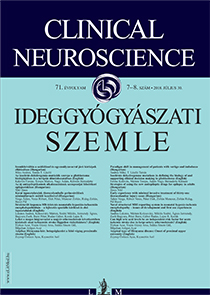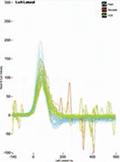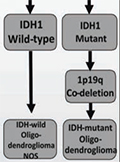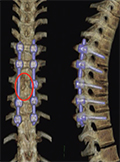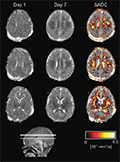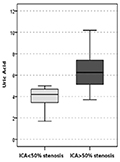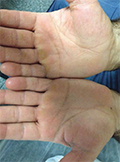The eLitMed.hu medical portal uses computer cookies for convenient operation. Detailed information can be found in the Cookie-policy.
Clinical Neuroscience - 2018;71(07-08)
Content
[Online supplementay figure to the article titled Novel structured MRI reporting system in neonatal hypoxic-ischemic encephalopathy - issues of development and first use experiences]
[Online supplementay figure to the article titled Novel structured MRI reporting system in neonatal hypoxic-ischemic encephalopathy - issues of development and first use experiences]
[Paradigm shift in management of patients with vertigo and imbalance]
[Dizziness is one of the most common causes of medical visits. Management of the dizzy patient may be challenging both for the general practitioner, in emergency departments, and special clinics, as behind a seemingly homogeneous clinical presentation several very different etiologies may occur. Research of the last two century enriched our knowledge about physiology and pathophysiology of the vestibular system. Much knowledge is now available about the labyrinth being able to sense head motions and gravity, processing of afferent vestibular stimuli, reflectory oculomotor and postural control, or recovery of the vestibular system. Based on scientific results new beside tests have been introduced including provocation maneuvers for detecting ectopic otoliths in different semicircular canals, head impulse test to examine function of the vestibulo-ocular reflex, and the HINTS+ battery for differentiation of peripheral or central origin of an acute vestibular syndrome. Technical innovations like videooculography and vestibular evoked myogenic potentials enable us to selectively and side-specifically examine the function of all six semicircular canals and two otolith organs. Pathomechanism of disorders with vertigo and dizziness became more clear resulting in the development or amendment of diagnostic criteria of several vestibular disorders including vestibular migraine, Menière’s disease, benign paroxysmal positional vertigo, persistent postural-perceptual dizziness, bilateral vestibulopathy. Broader knowledge about the pathomechanism promoted the development of new therapeutic methods like different repositioning maneuvers in benign paroxysmal positional vertigo, pharmaceutical therapies, vestibular rehabilitation, and psychotherapy. We aimed to summarize the novelties in the field of oto-neurology.]
Isocitrate dehydrogenase mutations in defining the biology of and supporting clinical decision making in glioblastoma
Background and purpose - Oncogenesis is related to a sequential accumulation of somatic mutations. Comprehensive characterizations of the genomic landscapes have been completed recently for several tumors, glioblastoma being among the first ones. Our own translational research studies have been focused on defining molecular subtypes of glioblastoma in the clinical setting because of an expected prognostic and therapeutic utility of the information. Somatic mutations in genes of the isocitrate dehydrogenase (IDH) enzyme family appear to be among the best-defined biomarkers that also influence tumor behavior and confer clinical utility. Methods - We have reviewed the literature including our own results to summarize basic science and clinical correlates of IDH mutations. Results - The surveyed data reveal genomic, transcriptomic, epigenomic and biochemical consequences of IDH mutations in the context of glioblastoma biology and phenotype. In addition, a few studies highlight the therapeutic potential of targeting IDH, although thus far all tests have only been conducted in the preclinical setting. Conclusions - Somatic mutations in isoforms of IDH genes represent important biomarkers that correlate with biochemical, biological and phenotypic features of glioblastoma, and may also facilitate the development of new therapeutic strategies complementing the currently available approved protocols.
[Strategies of using the new antiepileptic drugs for epilepsy in adults]
[The new antiepileptic drugs have not changed the basic pharmacological treatment principles of epilepsy, but they have given greater choice in focal and in generalized epilepsies as well. The new drugs are not necessarily more effective than traditional drugs, but they have favourable pharmacokinetic characteristics, fewer interactions and better adverse effect profile in the acute and chronic phase of the treatment. They generally show a lower teratogenicity risk than the standard antiepileptics, although carbamazepine, one of the standard drugs can be used and zonisamide, a new one must be avoid in pregnancy. Due to characteristics mentioned above they are not only effective as add-on therapy, but in monotherapy as well. On the basis of the international and national recommendation lamotrigine and levetiracetam belong to the first line antiepileptics. The favourable tolerability of the new antiepileptics may improve the patient’s compliance and adherence to the given treatment. The low teratogenicity makes them especially suitable for the treatment of women of childbearing age. The new antiepileptic drugs can succesfully used for the treatment of special patients’ groups as for the post stroke, poszttraumatic epilepsies, for the epilepsies accompanied with brain tumours as well as for epilepsies in the elderly. The new drugs are advantageous for the treatment of such patients who have psychiatric symptoms or signs of cognitive decline and high risk of these symptoms respectively.]
[Early experience with minimal invasive treatment of thirty-one thoracolumbar injury cases]
[A szerzők 31 thoracolumbalis gerincsérült minimálisan invazív műtéti ellátásával szerzett tapasztalataikról számolnak be. A betegek orvosi dokumentációját, radiológiai (preoperatív CT és MRI, valamint posztoperatív CT három és hat hónap után) képanyagát retrospektíven elemzik. A be-avatkozások során minden behelyezett csavar megfelelő pozícióba került, idegrendszeri funkcióromlás és sebfertőzés nem fordult elő. Az utánkövetés során három esetben alakult ki radiológiai korrekcióvesztés, melynek azonban klinikai következménye nem volt. Csavarlazulást, a fémanyag törését nem észleltük. Saját tapasztalataink alapján, a nemzetközi irodalmi adatokkal egybevágóan, a mini-málisan invazív módszer alkalmazását a gerincsérültek ellátása során javasoljuk.]
Novel structured MRI reporting system in neonatal hypoxic-ischemic encephalopathy - issues of development and first use experiences
Purpose - To develop an evidence-based, standardized structured reporting (SR) method for brain MRI examinations in neonatal hypoxic-ischemic encephalopathy (HIE) suitable both for clinical and research use. Materials and methods - SR template development was based on comprehensive review of the pertinent literature with the basic sections and subdivisions of the template defined according to MRI sequences (both conventional and diffusion-weighted, MR-spectroscopy (MRS), and T2*-weighted imaging), and the items targeted on age-related imaging patterns of HIE. In order to evaluate the usability of the proposed SR template we compared data obtained from the brain MR image analysis of 87 term and 19 preterm neonates with the literature. The enrolled 106 infants were born between 2013 and 2015, went through therapeutic hypothermia according to the TOBY criteria due to moderate to severe asphyxia and had at least one brain MRI examination within the first two weeks of life. Ethical approval was obtained for this retrospective study. Descriptive statistical analysis was also performed on data exported from the structured reporting system as feasibility test. Results - The mean gestational age of the study population was 38.3±2.2 weeks; brain MRI was performed on 5.8±2.9 day of life, hence in 78% of our patients after the conclusion of therapeutic hypothermia. Our main imaging findings were concordant to the pertinent literature. Moreover, we identified a characteristic temporal evolution of diffusion changes. Interestingly 18% (n=19/106) of the clinically asphyxiated infants had isolated axial-extraaxial haemorrhage without any imaging sign of HIE. Conclusion - In this article our approach of reporting HIE cases with our novel SR template is described. The SR template was found suitable for reporting HIE cases, moreover it uncovered time and location dependent evolution of diffusion abnormalities (and pseudonormalization, as well), suggesting its usefulness in clinical research applications. The high number of isolated intracranial haemorrhages, and the changing diffusion pattern emphasizes the importance of early imaging in HIE.
Can high uric acid levels be an independent risk factor for acute ischemic stroke due to large-artery atherosclerosis?
Introduction - Uric acid is a molecule that is known to act as a natural antioxidant in acute oxidative stress conditions such as acute ischemic stroke (AIS). Although there are several studies on the prognostic value of serum uric acid (UA) level, especially the AIS, its importance in ischemic stroke is still controversial. Our aim in this study is to investigate whether the serum UA level is an indicative biomarker in the large-artery atherosclerosis in the AIS etiology. Material and method - Of the patients admitted to Sakarya University Training and Research Hospital Depart-ment of Neurology between January 2017 and November 2017, 91 hospitalized patients, who had AIS diagnosis and had their uric acid levels measured, were analyzed retrospectively. Patients with diabetes mellitus (DM), hypertension (HT), smoking habit, obesity, gout, hyperlipidemia (HL) and renal failure were excluded from the study. Patients were classified as anterior system and posterior system infarct. Then, patients were divided into two groups, one with internal carotid artery (ICA) > 50% stenosis and the other with ICA < 50% stenosis according to carotid-vertebral artery doppler USG examination performed for etiology. Serum UA, total bilirubin, direct bilirubin and indirect bilirubin levels of both groups were statistically compared. Results - In the comparison of serum UA values of ICA>50% stenosis and ICA<50% stenosis group of AIS patients, a statistically significant difference was found between the UA levels (p<0.000), but there was no difference between total bilirubin, direct bilirubin and indirect bilirubin values (p>0.05). Conclusion - High uric acid levels can be considered an independent, indicative risk factor for large-artery disease in AIS.
Atypical type of Hirayama disease: Onset of proximal upper extremity
Hirayama disease is a rare, benign motor neuron disease. It has been proposed that the dura mater’s posterior wall lacks sufficient elasticity in the lower cervical region and this causes the tense dura part to displace anteriorly upon flexion. The disease is described as involving unilateral upper extremity with a distal-onset. We reported weakness and atrophy of the proximal part of an extremity in a 45-year-old man who is diagnosed with Hirayama disease. Proximal onset is a rare type of Hirayama Disease. Clinicians must be alert of proximal involvement and the diagnosis should be confirmed with electrophysiological and flexion MRI studies.
1.
Clinical Neuroscience
Is there any difference in mortality rates of atrial fibrillation detected before or after ischemic stroke?2.
Clinical Neuroscience
Factors influencing the level of stigma in Parkinson’s disease in western Turkey3.
Clinical Neuroscience
Neuropathic pain and mood disorders in earthquake survivors with peripheral nerve injuries4.
Journal of Nursing Theory and Practice
[Correlations of Sarcopenia, Frailty, Falls and Social Isolation – A Literature Review in the Light of Swedish Statistics]5.
Clinical Neuroscience
[Comparison of pain intensity measurements among patients with low-back pain]1.
2.
Clinical Neuroscience Proceedings
[A Magyar Stroke Társaság XVIII. Kongresszusa és a Magyar Neuroszonológiai Társaság XV. Konferenciája. Absztraktfüzet]3.
4.
Journal of Nursing Theory and Practice
[A selection of the entries submitted to the literary contest "Honorable mission: the joys and challenges of our profession" ]5.
Journal of Nursing Theory and Practice
[End of Life and Palliative Care of Newborns in the Nursing Context]